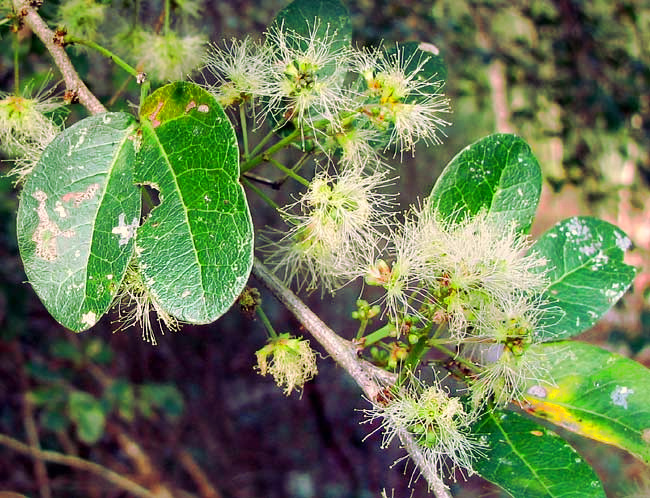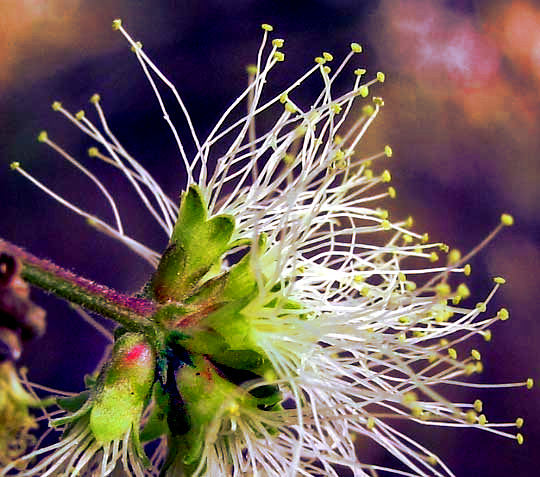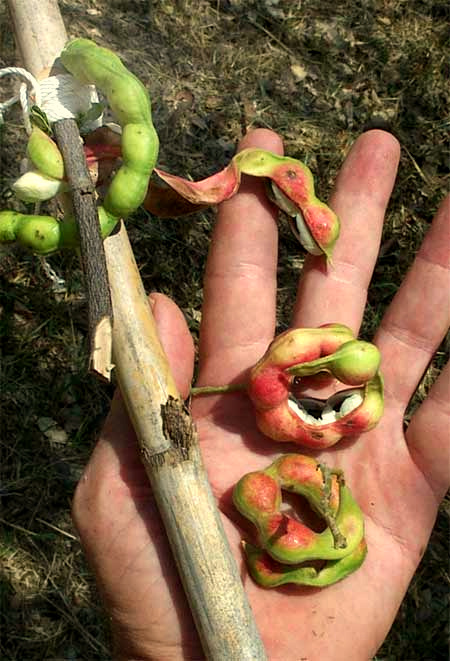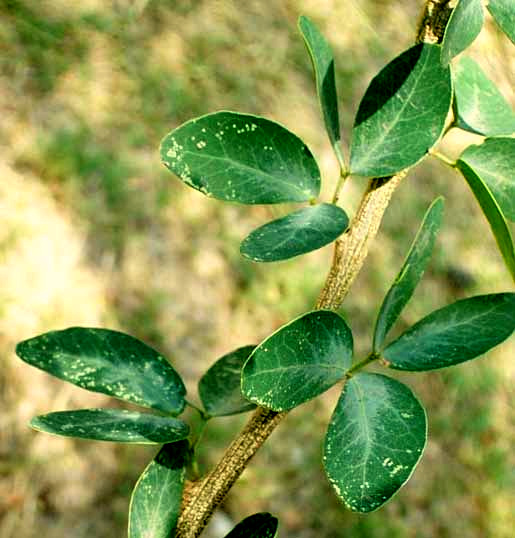Excerpts from Jim Conrad's
Naturalist Newsletter

from the February 21, 2010 Newsletter issued from Hacienda Chichen Resort beside Chichén Itzá Ruins, central Yucatán, MÉXICO
TS'IUCHÉ'S WARM, SLEEPY, HAY-FIELD-IN-MAY ODOR
Back in Querétaro, Don Gonzalo introduced us to the sweetly edible white pulp inside the large, curly legume of Guamuchil, Pithecellobium dulce, which becomes available in May at the dry season's end. (next entry) Remembering that good eating, when trees here with leaves seemingly identical to the Guamuchil's turned up, I began looking forward to some tasty meals. This week those trees are flowering abundantly, as shown above.
I mentioned the find to José, supposing that Guamuchil pods must be a big item in Maya cuisine, but was surprised when my description of the legume and its sweet pulp drew a blank from him. Still, he has a name for the tree in Maya: Ts'iuché, if I'm hearing the pronunciation right. However, I'm fairly sure that it's the same tree we saw in Querétaro, PITHECELLOBIUM DULCE.
We're well into the dry season now, with the forest having a crunchy, dusty feeling to it, so Ts'iuché's abundant blossoms caused the 15-ft-tall tree to seem like a spring bouquet in the desert. Untold numbers of honeybees could be heard buzzing from a good distance away. As you approached, the flowers' fragrance was like what you smell walking by a freshly mown hayfield in May -- the sublimely sweet odor that makes you sleepy and almost want to sneeze. A flower close-up is below:

These flowers look a lot like acacia flowers. However, if you look with a hand lens as a Pithecellobium's stamens -- the white, hairy things in the picture -- you find that the stamens' stems, or filaments, are joined to one another at their bases, forming a short cylinder around the female parts. An acacia flower's numerous stamens are not connected, and that distinguishes acacias not only from Pithecellobiums but also from members of the important genera Albizia and Calliandra. It's a good field mark to keep in mind.
from the May 19, 2007 Newsletter, Issued from Sierra Gorda Biosphere Reserve Headquarters in Jalpan, Querétaro, MÉXICO
CURLED BEAN PODS ALONG SIDEWALKS
Suddenly something new is appearing in the trash thrown along sidewalks and in the streets. It's a knobby looking, curiously curled, fair-sized bean pod, and usually it's been pried open and robbed of its beans. I knew what they were when I first saw them because I've been waiting for them. For weeks I've watched the pods ever so slowly maturing on medium-sized trees abundantly appearing as street trees and in people's yards. At last those pods are maturing, and each day you see people with long poles poking at high-hung pods.
Some of those trees grow here among the reserve's office buildings, so naturally Don Gonzalo fixed himself a 15-ft-long bamboo pole with a hook on it. You can see his creation, along with some hook-snatched, knobby, curled-up pods lying in my hand, below:

Note the Don's ingenuous manner of securing a hook onto the bamboo pole. A backward-pointing stick inserted into the bamboo stem's hollow interior has been secured with string, and made to angle outward by a wad of green leaves stuffed beneath the stick and filling the cavity. When snagged with this pole the pods stay wedged within the hook instead of falling to the ground. People up north in fig-picking territory should remember this design.
The pods are produced by a tree member of the Bean Family, PITHECELLOBIUM DULCE. In English the main name for it appears to be Manila Tamarind, but that's unfair, since it's a native Mexican tree and was introduced into Manila, as it also was in many other tropical areas. In Hawaii it's even become a weed tree. Around here the tree is called Guamuchil.
When the legumes mature they acquire a rosy blush on their exterior, split, and expose a white, pulpy material inside which black, shiny beans are embedded. You peel open the pods the way you would a big garden bean, eat the white stuff, and throw away the hard, black bean. Some trees produce sweeter pulp than others.
Botanically, the edible white pulp is the seed's "aril," which is an outgrowth from the funicle, which is the umbilical-cord-like thing connecting the seed to the pod's midrib. In some seeds arils are bright and showy, helping attract potential, hungry seed-disseminators.
The "dulce" in the species' Latin name led me to expect the white aril to be sweet, since that's what "dulce" means. However, I found it about as bitter as it was sweet. In my opinion, this is another example of nature creating something that's good-tasting enough to make you snack on it as you walk down a road, but not good enough to make a memorable meal.
Local Mexicans seem to relish them much more than I. The pods are even on sale in the market. I expect it's one of those cultural things, like Limburger cheese or gefiltafish: You have to be born into the culture to really appreciate it.

Guamuchil's leaves are easy to recognize. Above you can see how the compound leaves alternate upon the stem. Each leaf consists of two leaflets which in turn are divided into two asymmetrical leaflets, looking like butterfly wings. Therefore, each leaf consists of four leaflets.
from the January 29, 2012 Newsletter issued from Hacienda Chichen Resort beside Chichén Itzá Ruins, central Yucatán, MÉXICO
PITHECELLOBIUMS FRUITING
This week two intertwining Pithecellobium pods are ripening beside the hut, prettily displaying the bright colors shown below:

Pithecellobium dulce is a member of the Bean Family, so the two fruits in the picture are legumes. On the morning after the above picture was taken the red, empty pods were found on the ground emptied of their seeds and arils.